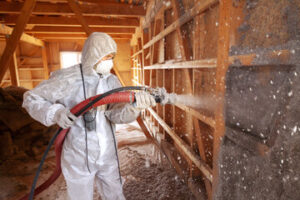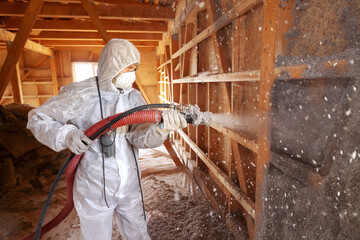Spray Insulation is a type of foam insulation that consists of two or more chemicals that are mixed together in a spray gun. Once mixed, the foam is applied to the building using two or three passes. The first pass is usually no more than 1/2 inch thick, and the second and third passes can be up to 3 inches thick. After the first pass, the foam must be allowed to cool. The cooling time is about 10 to 15 minutes per inch of foam thickness, and a maximum of 30 to 45 minutes for a three-inch thick layer. 
Open-cell spray foam is a type of building insulation. This type of foam is made from two different chemical components that are kept separate. They mix when pumped through a heated hose to create a solid-like material. These types of insulation have a variable R-Value but can provide excellent insulation for most buildings.
While closed-cell foam is stronger than open-cell foam, it requires more chemical material per volume. As a result, it is more expensive to purchase and install. Open-cell foam has fewer overall advantages, but is a superior sound-deadening material and is stronger than cellulose or fiberglass. However, it is not ideal for homes with drafty areas. Open-cell spray foam is more commonly used in colder climates and is more energy efficient than closed-cell foam.
Open-cell spray foam insulation is softer and more flexible than closed-cell spray foam. The difference between open-cell and closed-cell spray foam insulation is the number of tiny bubbles in each piece. Open-cell foam has smaller bubbles that are partially ruptured, while closed-cell foam contains larger, closed pockets that enhance the rigidity of the material.
There are many advantages to open-cell foam insulation, but they also have their disadvantages. You should consider the benefits and drawbacks of each type before you decide which type to use. Open-cell foam is a better option for some applications, and closed-cell foam is best for other applications.
Self-adhesive spray insulation is an excellent choice for a variety of home insulation projects. This type of spray is available in a variety of sizes and types and has a bonding time of one to 30 minutes. It is also suitable for landscaping and roofing.
Self-adhesive insulation tapes are typically available in two-inch-wide rolls and are suitable for most pipe diameters. They should be applied to the inside surface of the pipe or tube and may be butted or overlapped. It is important to apply the tape while the material is dry and above 40 degrees F.
A quality self-adhesive is non-flammable and non-wrinkling. It is also highly resistant to temperature and water. Self-adhesive spray insulation is a high-quality construction adhesive. Whether it is used in a home or office building, it will ensure a strong, long-lasting bond.
AlbaChem Super 88 is a versatile, industrial-grade adhesive that tacks up fast and will not wrinkle on even the roughest surfaces. It bonds a variety of materials, including plastics and foils. It is suitable for applying insulation and corner patch assemblies and is water resistant.
When you have spray insulation installed, it’s important to know the health risks associated with this process. One of the main concerns is the chemical content of spray foam. It contains methylene diphenyl diisocyanate (MDI), which contains benzene, chlorine compounds, and formaldehyde. These compounds are known carcinogens and bioaccumulative toxicants.
In addition to creating hazardous fumes, spray foam insulation is also dangerous to the environment. Though the chemicals are considered inert after drying, their residual effects can cause respiratory and eye problems. Workers must wear appropriate protective gear. Even after the spray foam has completely dried, the dust may contain hazardous chemicals. For this reason, it is recommended that you consider using an alternative type of insulation.
Another risk associated with spray insulation is the presence of a fishy odor. This is caused by improper installation of the product. The odor can make a home uninhabitable. To minimize this risk, be sure to handle the material with care and respect. If you are not sure whether or not your insulation is safe to use, talk to a professional.
Another potential concern with spray insulation is the exposure to boric acid, which is a pesticide and flame retardant. This substance is especially problematic during installation, when workers may be exposed to a high concentration of boric acid. Further, research is needed to determine the extent to which boron-based flame retardants may migrate into the air.
According to the Environmental Protection Agency (EPA), some spray polyurethane foam (SPF) insulation poses a risk to the health of workers. The chemicals contained in SPF insulation can cause eye irritation, respiratory irritation, and asthma. It can also result in chemical sensitization in some people.
While spray foam insulation provides a wide range of benefits, the chemicals present in it can be hazardous to the health of the people who work with it. For this reason, workers must wear protective clothing and avoid skin contact with the chemicals. Furthermore, residents should leave the home for at least 24 hours following its application.

